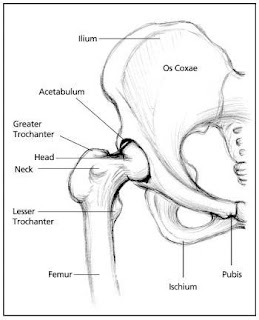Yesterday, I saw a 13 year old boy who was brought to our clinic by his parents as he had knee pain as well as a "snapping" hip on the same side. After joining the school's softball team earlier this year, he had trained a fair bit more than in primary school.
He recently developed right knee pain and had a year's history of pain and "snapping" in his right hip. He had previously seen a chiropractor for the last few months. Treatment consisted of stretching the hip flexors, the
Iliotibial band (ITB) and manipulating his hip and spine. He did not get any better after all the treatment with the chiropractor.
I assessed him and confirmed that his
knee pain was coming from his tibial tuberosity and indicative of
doing too much too soon. That's not too difficult to manage. He definitely had a case of
Osgood Schlatter's in his right knee.
There was no pain with clicking in his hip. Nor was locking observed at end of range hip flexion with added internal or external rotation (this rules out hip labral tear). Range of movement in his back, hips, knees and ankles was normal and symmetrical.
There was weakness in his right
Gluteus Medius muscle, also his painful knee and snapping hip side, despite that being his dominant side. This
greater contralateral pelvic drop was confirmed while watching him run.
The "snapping hip" sound was reproduced over his right greater trochanter when he was in left side lying when I straightened and bent his right hip. It was a fairly loud "clicking" and/or "snapping" sound each time I bent and straightened his hip. There was some local tenderness over his
Gluteus Medius, Gluteus Maximus and Tensor Fascia Lata muscles and over the greater trochanter itself.
 |
| Snapping hip on outside part of R hip |
This explained his "snapping hip" on the outer part of his hip. While my young patient did have pain over his outer hip, I've treated other cases where patients did not complain of pain there with the exact same condition.
Following treatment, my patient was pain free and I taught him and his parents what to do to maintain that.
This "snapping hip"condition is also known as Coxa Saltans, can also happen in adults. My young patient described above has a extra articular or outside the hip joint condition. It can also be intra articular or inside the hip joint.
 |
| It's Psoas Major/ Iliacus if inner part of R hip |
If the condition occurs on the inner part of the hip, extra articularly, it is usually due to the Psoas Major or Iliacus muscle. A snapping hip inside the hip is usually confirmed by an
MRI. Those who have intra articular hip snapping will usually complain of hip catching, painful clicking or locking. And that will probably have to be another post.
Reference
Winston P, Awan R et al (2007). Clinical Examination And Ultrasound Of Self-Reported Snapping Hip Syndrome In Elite Ballet Dancers. AJSM. 35(1): 118-126. DOI: 10.1177/0363546506293703.


















